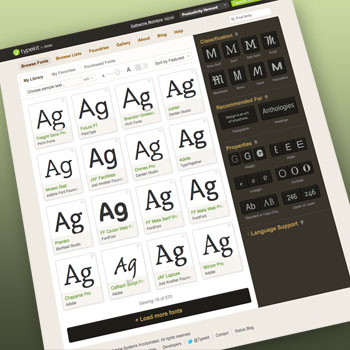
Why does your website need real fonts instead of just using images?
- Quicker load times. Images take much longer to load than html text.
- Better compatibility with mobile devices. These days, 46% of American adults own a smartphone. (Source: Pew Internet). Real web fonts allow for dynamic resizing of text and increase the readability of your content on these devices.
- Quicker, more affordable website maintenance. With html text, editing a headline is quick and easy; whereas with an image, a graphics editor like Adobe Photoshop is needed. It must then be saved as a web-friendly file, uploaded, and linked in your page. And, you must have the correct font file installed on your computer.
- Better search-engine ranking. Search engines such as Google and Bing read html headlines but they don’t read the text in images. Therefore, any text used in a graphic needs to be added to the code on the page manually — adding maintenance costs and load time.
- Better accessibility to your content. Some web users — often those with hearing or visual impairment — prefer to read web pages with images turned off. If an important headline is an image, these readers will never see it. In addition, screen readers (a tool for web users with visual impairment) are incapable of reading images that do not have text provided as an alt tag. With web fonts, screen readers will be able to read headlines and sub-headlines, creating a more streamlined and enjoyable web experience.
- In some cases – it’s the law! Federal agencies must provide a text equivalent to all content provided in images, video, and audio files to comply with Section 508 of the US Rehabilitation Act. Section 508 requires that electronic and information technology that is developed or purchased by Federal agencies must be accessible by people with disabilities.
How’s it work?
In 2009, a company called Typekit began hosting and serving up web fonts that render beautifully in most web browsers. They took painstaking measures to optimize each font’s appearance in different operating systems and browsers, and at different weights and sizes. The company currently has more than 800 carefully selected fonts to choose from, including everything from ornate scripts to chunky serif typefaces. Google joined the mix in 2010 and is now offering more than 600 web fonts.
In most cases, your web designer or developer can sign up for one of these services and have compelling, web-friendly fonts on your website in a matter of hours or even minutes.
Interested in adding these fonts to your site? Contact us and we’ll have you set up with web fonts quickly and easily.

Of course with greater options comes greater responsibility. Just because you CAN use Brush Script, doesn’t mean you should! Anyway, excellent job detailing the reasons this is a big deal. Looking forward to seeing ways you have implemented this!
Very good point Norm, in fact Brush Script is available through Typekit! Sadly, Comic Sans isn’t 😀